

The Ultimate Guide on How to Organize a Bold Argumentative Essay
by Suzanne Davis | Jun 20, 2021 | Writing Essays and Papers , Writing Organization | 6 comments
Can you argue with me (in writing)?

That’s what I want my students to do. I want them to write a compelling argumentative essay that debates and challenges a point of view on a topic. And the secret to accomplishing that is knowing how to organize an argumentative essay. If you understand the parts and pieces that make up an outstanding argumentative essay, then you can write thorough, detailed, and persuasive content.
So, what’s an argumentative essay? It’s an essay where you take a stand on an issue and explain why your position is correct. It’s important to create an argumentative essay that explains and proves your thesis.
The key to doing this is by following a strong argumentative essay plan. There are other ways to organize your argumentative essay. But in this post, we’ll look at an easy plan that covers all the major parts you need in your essay.
And check out the video below to see how to use a checklist to help you organize an argumentative essay.
How to Organize an Argumentative Essay
The key pieces of this argumentative essay plan are:
- Introduction
- Body paragraphs that support the thesis
- Rebuttal paragraph/s
The Introduction to an Argumentative Essay
Your introduction is how you show the reader your point of view about the issue. It also sets up the organization of the rest of your essay. A solid introduction is a powerful way to start your essay. The elements of an argumentative essay introduction are:
Hook: This is a sentence that captures grabs your readers’ attention. A hook makes them curious about the topic of your essay.
4 hooks work great with argumentative essays:
- Ask an interesting question
- State a fact/statistic
- Make a strong statement
- Include a relevant and important quotation
Each of these hooks should relate to the specific topic in your paper.
For more information about essay hooks see- https://www.academicwritingsuccess.com/7-sensational-types-of-essay-hooks/
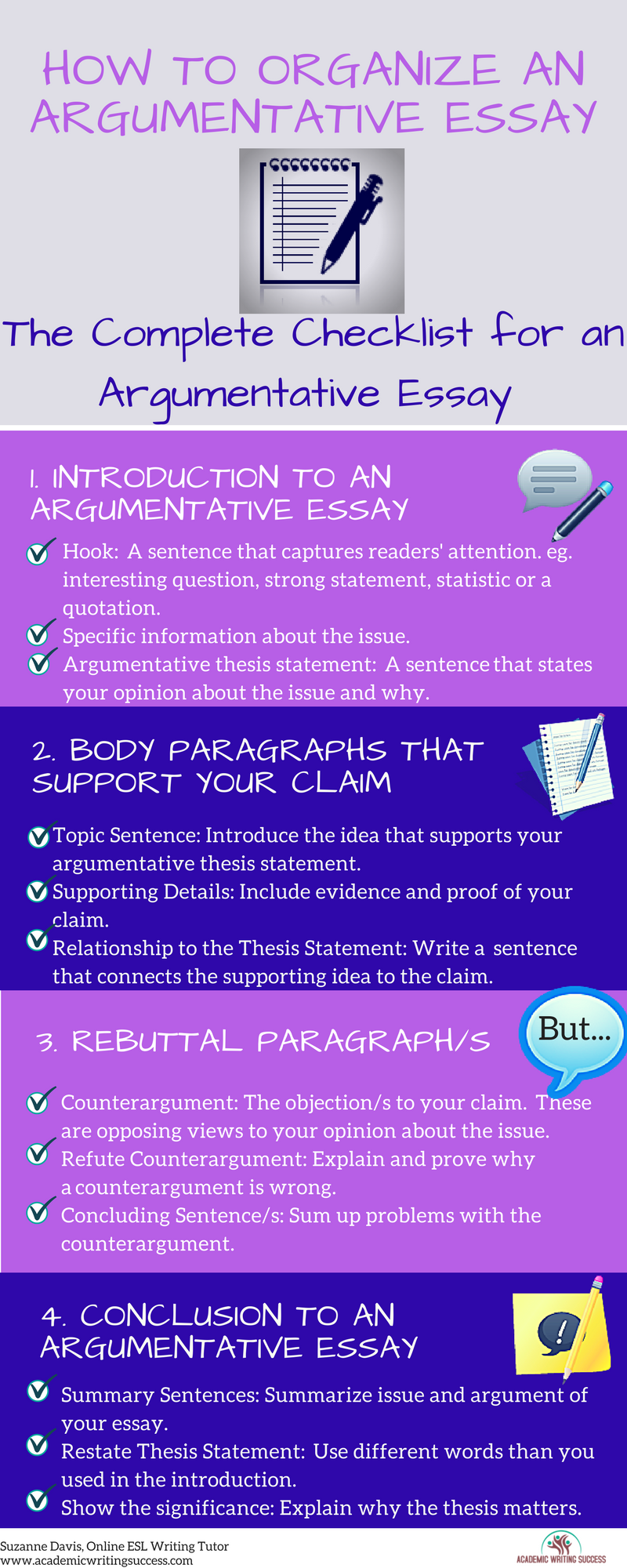
Ask yourself why does this topic matter? Who does it concer n? Write about that in these sentences leading up to your thesis statement.
Thesis Statement: The last sentence is your argumentative essay thesis statement. A thesis statement is your opinion about the main topic of your essay or paper.
An argumentative thesis statement begins with a debatable topic/issue. The thesis statement is your point of view about that issue and how you will prove it. This is the claim of your argumentative essay.
An example argumentative essay thesis statement is: Assault rifles should be banned in the United States because these weapons can kill many people in a matter of seconds.
Next, you write the body of your essay so that it supports this claim and overpowers arguments against it.
The Body of an Argumentative Essay
The body of an argumentative essay has 2 parts: Paragraphs that support your claim and 1 or 2 rebuttal paragraphs.
Supporting paragraphs and rebuttal paragraphs reflect the pros and cons of your claim about the issue.
Body Paragraphs that Support Your Claim
Topic Sentence: This sentence is a supporting idea related to your thesis statement. The main topic of the paragraph is the supporting idea.
Supporting Details : This is the substance of your paragraph. Supporting details are evidence that proves the supporting idea.
Relationship to the thesis statement: This is a concluding sentence that shows how the supporting idea ties back to your thesis statement. It will also connect or lead into the next paragraph that supports your claim.
Write a body paragraph for each of the ideas that support your claim.
Rebuttal Paragraph in an Argumentative Essay
A rebuttal paragraph is important because it shows you considered two sides of an issue. You thought about the other side of an issue, researched it, and found a way to argue against it.
This is a crucial part of your argumentative essay because it’s where you overrule other peoples’ objections.
The 3 parts of the rebuttal paragraph are:
- Counterargument
- Refuting the counterargument
- Concluding Sentence
Counterargument: A counterargument is an objection to your claim. You develop this by thinking of all the things the people opposed to your perspective.
The thesis statement from above is: Pinterest is the best social media platform for small online businesses to advertise their products and services because many people use Pinterest to make buying decisions.
Your counterargument is a reason/s people would argue against that claim:
Ex. Facebook is the largest social media platform, and more people visit Facebook every day. Most people only visit Pinterest a few times a week.
Refuting the counterargument: Here, you explain and prove why these counterarguments are wrong.
Ex. Yet, people who use Pinterest are 10% more likely to buy something they saw on Pinterest than on any other social media platform. https://blog.hootsuite.com/top-social-media-sites-matter-to-marketers/
Concluding sentence : This last part of the rebuttal paragraph sums up the problem with the counterargument.
The Conclusion to an Argumentative Essay
Your conclusion should show readers what you proved and why your thesis matters. These are the things you include in a conclusion to an argumentative essay:
Summary Sentences : Here, you recap the main points of your claim.
Restate the thesis statement : Use different words to restate your claim.
Significance: Here, you explain why the thesis you proved in your argumentative essay matters. Consider how it affects other people, the field you study, or the world. Ask yourself, “What should the reader take away from my paper?”
A solid plan for your argumentative essay will help you see the weaknesses and strengths in your argument before you start writing your essay. You can follow this same organization when you write a longer argumentative paper. The difference is that you add more supporting and rebuttal paragraphs to a longer paper.
Learn how to organize an argumentative essay, and you’ll find it easier to write and revise an argumentative paper too.
Download your free copy of “The Ultimate Argumentative Essay Checklist” to help you write and revise your next argumentative essay.
Wow, this is the most detailed and easy to follow explanation of how to write an argumentative essay. Thank you for how precise and clear you are.
You are very welcome. It’s much easier to write an argumentative essay with a clear plan for how to do things.
Suzanne, I love learning English once more. Most facts are long forgotten due to non-usage of those. But knowing and putting one’s knowledge into practice are completely two different things which is where your guidance becomes so crucial.
Nilanjana, I am glad you like learning English again. There is a difference between knowing a language and using it regularly. Please feel free to share any ideas of things you would like to learn. I love to write about English and writing.
This is an excellent article that give clear directions on how to approach argumentative essays. Students should always value a checklist and use it often. Writing is so much easier with a plan of attack!
Tutorpreneur Hero Award

http://becomeanonlinetutor.com/tutorpreneur-hero/
SSL Certificate Seal
Session expired
Please log in again. The login page will open in a new tab. After logging in you can close it and return to this page.
Privacy Overview

How to Use Graphic Organizers to Write Better Essays
Lucid Content
Reading time: about 6 min
If you’re a student, there’s no way around the inevitable: You’re going to have to write essays. Lots of essays. In fact, the five-paragraph essay is so fundamental to the high school curriculum that it’s still used on the ACTs, and knowing how to recognize the organizational structure of essays will help you score higher on the SATs.
Even though it seems like a chore, knowing how to organize and write an essay can have a lasting effect on your life, from getting into a better college to scoring a better job to performing better in that job long after your high school days are over.
Here’s a secret: Using graphic organizers for writing essays can help you write better essays faster. (And don’t count yourself out if you’re an educator—you can offer these tools to help your students succeed.) We’ll show you exactly how to do it.
Why use graphic organizers
When ACT graders or teachers are looking your essay, they’re looking for very specific criteria; essentially, they’re looking at how well you’ve organized your thoughts. Many students don’t take the time to outline their essay structure before writing, and that always means a lower score on a test and a lower grade on the essay in class.
Using a writing template can feel like an unnecessary step in an already complicated process. If you need extra motivation to implement these organizers into your writing routine, consider all of their benefits. Graphic organizers can help you:
- Save time by showing you where each piece of the essay “lives.”
- Have more productive brainstorming sessions, either by yourself or with a group.
- Make connections between ideas and create a more cohesive argument.
- Pinpoint holes in your arguments and either adjust the thesis or find supporting statements.
- Keep track of your research.
- Organize your thoughts and come to interesting, more compelling conclusions.
- Stay in the right direction when you feel lost in a sea of words.
- Manage anxiety by converting the fear of a blank assignment into an action plan with a clear map.
With all those benefits, it’s hard to ignore how useful and vital graphic organizers are to writing. And once you’ve become adept at organizing your thoughts for something like a school essay, you’ll find that skill carries with you throughout your life, whether you’re trying to become a more intelligent debater to negotiate prices. It goes beyond just the essay to becoming a better thinker. And it starts with a simple template.
We’ll walk you through several use cases for graphic organizers and provide templates for you to download and fill in when you’re ready to write.
Brainstorming graphic organizers
Brainstorming is important, not only to come up with ideas for topics but to determine what information you need to include in the essay once you’ve determined your topic. Though many think of brainstorming as just freeflow thinking, brainstorming is most productive when you work within specific parameters.
That’s why essay brainstorming graphic organizers are useful, whether you’re using one to brainstorm on your own or you’re working with a group.
In Lucidchart, our mind map shapes and templates double as brainstorming graphic organizers. Start with an essay prompt as your central shape and then fill in the shapes that branch off your prompt with topic ideas. Alternatively, you can add your selected topic to the center and start brainstorming the different ideas you need to cover in your paper.
When the template is filled in, you’ll have a clear starting point for your essay or research paper.
Research paper graphic organizers
Nothing paralyzes students with fear quite like a research paper. These long-form papers require—as the name implies—quite a bit of research, and their purpose is to teach students how to look for valid sources to support their arguments.
But keeping track of all those sources and tying them into your argument can be tricky. That’s where a research paper graphic organizer can be a student’s greatest ally.

This template lays out the writing process itself. After you come up with a general topic, like “the disappearance of honey bees,” fill in the “Research Paper Topic” box.
Then, start looking for reputable sources (Wikipedia doesn’t count) and use the five sources boxes to hold the most relevant quotes and statistics you find. Using those quotes and statistics, you can then fill out a thesis statement that is supported by the research.
Then, you’ll be able to focus your paragraphs on a single topic each that supports the thesis statement and your overarching argument. After you’ve filled out the template, the backbone of the research paper is complete: All that’s left to do is fill in the spaces between sources and arguments.
5-paragraph essay graphic organizer
When it comes to writing the five-paragraph essay, writing diagrams are key. By using graphic organizers for writing, you’re no longer staring at a giant blank piece of paper with no idea how or where to begin. Your graphic organizer is your map.
Although using writing diagrams may seem time-consuming, the fact is that taking the time to fill a graphic organizer in before writing actually saves time. If there’s a problem with the argument, it will show up on the diagram, or if there’s not enough evidence to support your argument, you’ll know before you’ve wasted time writing the paper. And, as we said before, even if your writing is terrible, if your argument is sound, you’ll still score a decent grade.
Try this 5-paragraph essay template to get you started.

Don’t feel pressured to come up with a compelling title right away. Instead, it’s more important that you come up with a thesis statement that can be supported by three solid arguments. Fill in that thesis statement and your arguments. Then, for each argument, figure out three supporting details to support your case.
That’s it! You’ve got the most essential parts of your 5-paragraph essay completed.
Now, come up with an introduction that sets the stage for your argument and a conclusion that wraps up and restates your thesis and supporting arguments in a compelling way. Now you have a solid plan for your paper and can approach it with confidence.
If you’d like a more linear graphic that exactly follows the structure of the 5-paragraph, use the writing template below and follow the same process.

Visuals, such as graphic organizers for writing, can help you better understand concepts, think creatively, and collaborate with your classmates—and there are plenty of other templates where these came from.
Lucidchart offers hundreds of templates to help you through your studies, including timelines, Venn diagrams, word maps, and more. Sign up for Lucidchart and upgrade to an Educational account for free.
Resources for teachers
Providing graphic resources to students is essential; after all, many of your students will be visual learners, so while you may beautifully explain how the process works, there will be some who won’t understand until they see a template of the essay itself.
Lucidchart has many resources for teachers, from lesson plans to writing templates. While you’re teaching your students how to write essays or research papers, it’s useful to print out the templates and fill them out together (even using a completed template as a separate assignment with a separate grade) so that your students can get a feel for properly filling out graphic organizers before attempting it on their own.
Lucidchart, a cloud-based intelligent diagramming application, is a core component of Lucid Software's Visual Collaboration Suite. This intuitive, cloud-based solution empowers teams to collaborate in real-time to build flowcharts, mockups, UML diagrams, customer journey maps, and more. Lucidchart propels teams forward to build the future faster. Lucid is proud to serve top businesses around the world, including customers such as Google, GE, and NBC Universal, and 99% of the Fortune 500. Lucid partners with industry leaders, including Google, Atlassian, and Microsoft. Since its founding, Lucid has received numerous awards for its products, business, and workplace culture. For more information, visit lucidchart.com.
Related articles

Check out how Annika, a recent English graduate of the University of Michigan, used mind mapping in Lucidchart to develop her honors thesis.
Bring your bright ideas to life.
or continue with
Have a language expert improve your writing
Run a free plagiarism check in 10 minutes, generate accurate citations for free.
- Knowledge Base
- How to write an argumentative essay | Examples & tips
How to Write an Argumentative Essay | Examples & Tips
Published on July 24, 2020 by Jack Caulfield . Revised on July 23, 2023.
An argumentative essay expresses an extended argument for a particular thesis statement . The author takes a clearly defined stance on their subject and builds up an evidence-based case for it.
Instantly correct all language mistakes in your text
Upload your document to correct all your mistakes in minutes

Table of contents
When do you write an argumentative essay, approaches to argumentative essays, introducing your argument, the body: developing your argument, concluding your argument, other interesting articles, frequently asked questions about argumentative essays.
You might be assigned an argumentative essay as a writing exercise in high school or in a composition class. The prompt will often ask you to argue for one of two positions, and may include terms like “argue” or “argument.” It will frequently take the form of a question.
The prompt may also be more open-ended in terms of the possible arguments you could make.
Argumentative writing at college level
At university, the vast majority of essays or papers you write will involve some form of argumentation. For example, both rhetorical analysis and literary analysis essays involve making arguments about texts.
In this context, you won’t necessarily be told to write an argumentative essay—but making an evidence-based argument is an essential goal of most academic writing, and this should be your default approach unless you’re told otherwise.
Examples of argumentative essay prompts
At a university level, all the prompts below imply an argumentative essay as the appropriate response.
Your research should lead you to develop a specific position on the topic. The essay then argues for that position and aims to convince the reader by presenting your evidence, evaluation and analysis.
- Don’t just list all the effects you can think of.
- Do develop a focused argument about the overall effect and why it matters, backed up by evidence from sources.
- Don’t just provide a selection of data on the measures’ effectiveness.
- Do build up your own argument about which kinds of measures have been most or least effective, and why.
- Don’t just analyze a random selection of doppelgänger characters.
- Do form an argument about specific texts, comparing and contrasting how they express their thematic concerns through doppelgänger characters.
Receive feedback on language, structure, and formatting
Professional editors proofread and edit your paper by focusing on:
- Academic style
- Vague sentences
- Style consistency
See an example

An argumentative essay should be objective in its approach; your arguments should rely on logic and evidence, not on exaggeration or appeals to emotion.
There are many possible approaches to argumentative essays, but there are two common models that can help you start outlining your arguments: The Toulmin model and the Rogerian model.
Toulmin arguments
The Toulmin model consists of four steps, which may be repeated as many times as necessary for the argument:
- Make a claim
- Provide the grounds (evidence) for the claim
- Explain the warrant (how the grounds support the claim)
- Discuss possible rebuttals to the claim, identifying the limits of the argument and showing that you have considered alternative perspectives
The Toulmin model is a common approach in academic essays. You don’t have to use these specific terms (grounds, warrants, rebuttals), but establishing a clear connection between your claims and the evidence supporting them is crucial in an argumentative essay.
Say you’re making an argument about the effectiveness of workplace anti-discrimination measures. You might:
- Claim that unconscious bias training does not have the desired results, and resources would be better spent on other approaches
- Cite data to support your claim
- Explain how the data indicates that the method is ineffective
- Anticipate objections to your claim based on other data, indicating whether these objections are valid, and if not, why not.
Rogerian arguments
The Rogerian model also consists of four steps you might repeat throughout your essay:
- Discuss what the opposing position gets right and why people might hold this position
- Highlight the problems with this position
- Present your own position , showing how it addresses these problems
- Suggest a possible compromise —what elements of your position would proponents of the opposing position benefit from adopting?
This model builds up a clear picture of both sides of an argument and seeks a compromise. It is particularly useful when people tend to disagree strongly on the issue discussed, allowing you to approach opposing arguments in good faith.
Say you want to argue that the internet has had a positive impact on education. You might:
- Acknowledge that students rely too much on websites like Wikipedia
- Argue that teachers view Wikipedia as more unreliable than it really is
- Suggest that Wikipedia’s system of citations can actually teach students about referencing
- Suggest critical engagement with Wikipedia as a possible assignment for teachers who are skeptical of its usefulness.
You don’t necessarily have to pick one of these models—you may even use elements of both in different parts of your essay—but it’s worth considering them if you struggle to structure your arguments.
Regardless of which approach you take, your essay should always be structured using an introduction , a body , and a conclusion .
Like other academic essays, an argumentative essay begins with an introduction . The introduction serves to capture the reader’s interest, provide background information, present your thesis statement , and (in longer essays) to summarize the structure of the body.
Hover over different parts of the example below to see how a typical introduction works.
The spread of the internet has had a world-changing effect, not least on the world of education. The use of the internet in academic contexts is on the rise, and its role in learning is hotly debated. For many teachers who did not grow up with this technology, its effects seem alarming and potentially harmful. This concern, while understandable, is misguided. The negatives of internet use are outweighed by its critical benefits for students and educators—as a uniquely comprehensive and accessible information source; a means of exposure to and engagement with different perspectives; and a highly flexible learning environment.
The body of an argumentative essay is where you develop your arguments in detail. Here you’ll present evidence, analysis, and reasoning to convince the reader that your thesis statement is true.
In the standard five-paragraph format for short essays, the body takes up three of your five paragraphs. In longer essays, it will be more paragraphs, and might be divided into sections with headings.
Each paragraph covers its own topic, introduced with a topic sentence . Each of these topics must contribute to your overall argument; don’t include irrelevant information.
This example paragraph takes a Rogerian approach: It first acknowledges the merits of the opposing position and then highlights problems with that position.
Hover over different parts of the example to see how a body paragraph is constructed.
A common frustration for teachers is students’ use of Wikipedia as a source in their writing. Its prevalence among students is not exaggerated; a survey found that the vast majority of the students surveyed used Wikipedia (Head & Eisenberg, 2010). An article in The Guardian stresses a common objection to its use: “a reliance on Wikipedia can discourage students from engaging with genuine academic writing” (Coomer, 2013). Teachers are clearly not mistaken in viewing Wikipedia usage as ubiquitous among their students; but the claim that it discourages engagement with academic sources requires further investigation. This point is treated as self-evident by many teachers, but Wikipedia itself explicitly encourages students to look into other sources. Its articles often provide references to academic publications and include warning notes where citations are missing; the site’s own guidelines for research make clear that it should be used as a starting point, emphasizing that users should always “read the references and check whether they really do support what the article says” (“Wikipedia:Researching with Wikipedia,” 2020). Indeed, for many students, Wikipedia is their first encounter with the concepts of citation and referencing. The use of Wikipedia therefore has a positive side that merits deeper consideration than it often receives.
An argumentative essay ends with a conclusion that summarizes and reflects on the arguments made in the body.
No new arguments or evidence appear here, but in longer essays you may discuss the strengths and weaknesses of your argument and suggest topics for future research. In all conclusions, you should stress the relevance and importance of your argument.
Hover over the following example to see the typical elements of a conclusion.
The internet has had a major positive impact on the world of education; occasional pitfalls aside, its value is evident in numerous applications. The future of teaching lies in the possibilities the internet opens up for communication, research, and interactivity. As the popularity of distance learning shows, students value the flexibility and accessibility offered by digital education, and educators should fully embrace these advantages. The internet’s dangers, real and imaginary, have been documented exhaustively by skeptics, but the internet is here to stay; it is time to focus seriously on its potential for good.
If you want to know more about AI tools , college essays , or fallacies make sure to check out some of our other articles with explanations and examples or go directly to our tools!
- Ad hominem fallacy
- Post hoc fallacy
- Appeal to authority fallacy
- False cause fallacy
- Sunk cost fallacy
College essays
- Choosing Essay Topic
- Write a College Essay
- Write a Diversity Essay
- College Essay Format & Structure
- Comparing and Contrasting in an Essay
(AI) Tools
- Grammar Checker
- Paraphrasing Tool
- Text Summarizer
- AI Detector
- Plagiarism Checker
- Citation Generator
An argumentative essay tends to be a longer essay involving independent research, and aims to make an original argument about a topic. Its thesis statement makes a contentious claim that must be supported in an objective, evidence-based way.
An expository essay also aims to be objective, but it doesn’t have to make an original argument. Rather, it aims to explain something (e.g., a process or idea) in a clear, concise way. Expository essays are often shorter assignments and rely less on research.
At college level, you must properly cite your sources in all essays , research papers , and other academic texts (except exams and in-class exercises).
Add a citation whenever you quote , paraphrase , or summarize information or ideas from a source. You should also give full source details in a bibliography or reference list at the end of your text.
The exact format of your citations depends on which citation style you are instructed to use. The most common styles are APA , MLA , and Chicago .
The majority of the essays written at university are some sort of argumentative essay . Unless otherwise specified, you can assume that the goal of any essay you’re asked to write is argumentative: To convince the reader of your position using evidence and reasoning.
In composition classes you might be given assignments that specifically test your ability to write an argumentative essay. Look out for prompts including instructions like “argue,” “assess,” or “discuss” to see if this is the goal.
Cite this Scribbr article
If you want to cite this source, you can copy and paste the citation or click the “Cite this Scribbr article” button to automatically add the citation to our free Citation Generator.
Caulfield, J. (2023, July 23). How to Write an Argumentative Essay | Examples & Tips. Scribbr. Retrieved April 11, 2024, from https://www.scribbr.com/academic-essay/argumentative-essay/
Is this article helpful?

Jack Caulfield
Other students also liked, how to write a thesis statement | 4 steps & examples, how to write topic sentences | 4 steps, examples & purpose, how to write an expository essay, "i thought ai proofreading was useless but..".
I've been using Scribbr for years now and I know it's a service that won't disappoint. It does a good job spotting mistakes”
Persuasion Map
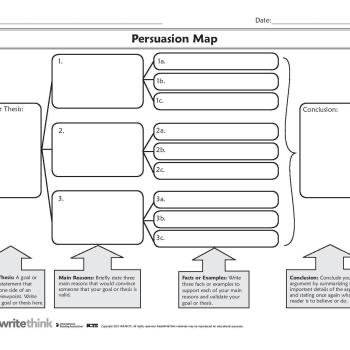
About this printout
Use this graphic organizer to develop a persuasive stance for an essay, speech, poster, or any type of assignment that incorporates persuasion.
Teaching with this printout
More ideas to try, related resources.
Examples of persuasion surround our lives, and the ability to persuade others is a powerful asset. We can persuade people to act in our favor, help them to see our point of view, and sway their opinion to that of our own. The power of persuasion is far reaching, and it is a technique that students will use throughout their lives. This tool helps students formulate ideas for a persuasive argument by helping them determine their goal or thesis, identify three reasons to support it (with three facts or examples to support each reason), and restate the thesis in a conclusion statement. Before your students use this tool independently, model its use for them. Choose a simple topic (such as, “Sixth Grade is the Best Grade” or “Why Our Lunch Period Should be Longer”). Then, fill in the Persuasion Map while discussing the process aloud, displaying the tool so that all students can see it. Review students’ completed maps prior to having them continue with the persuasion assignment. This will provide you with an opportunity to check students’ understanding of persuasion and help those who need extra instruction.
- Have students analyze a persuasive piece (for example, an advertisement or editorial in a newspaper or magazine) by filling in the map and discussing the authors’ strategies of persuasion.
- Encourage older students to create propaganda-based assignments by having them incorporate deceptive language in some of the “reasons” or “examples” on their maps. (Propaganda is a form of persuasion that uses deceptive language to exaggerate, distort, or conceal information.) Upon completion, have students read their maps orally and/or display them for their peers. Have students identify the deceptive language in their peers’ maps to create a class list of the examples used. As an additional follow-up, students can view and read advertisements, newspaper editorials, and other text that contain propaganda to search for use of the examples on the class list and to add additional ones.
- Have students complete two maps based on the same goal but with two different targeted audiences in mind. Attention to audience is an essential element of effective persuasion. For example, students might create maps to market a particular children’s toy; one map could target children as the audience, and the other could focus on parents as the audience. After they have completed their maps, have students read them to the class without identifying the intended audience. Ask the rest of the class to determine the intended audience and identify the specific clues that prompted their deductions. Finally, as a class, compare and contrast the language and words used for each intended audience.
- Lesson Plans
- Student Interactives
- Strategy Guides
Through a classroom game and resource handouts, students learn about the techniques used in persuasive oral arguments and apply them to independent persuasive writing activities.
The Persuasion Map is an interactive graphic organizer that enables students to map out their arguments for a persuasive essay or debate.
- Print this resource
Explore Resources by Grade
- Kindergarten K
- Our Mission
Exploring Argument Writing With Visual Tools
Teachers can have students use graphic organizers and timelines to clarify their thinking during the writing process.

As a teacher who loves to write and engage students with writing, I’ve experienced many challenges in attempting to bring composition into the classroom. While some students readily fill up blank pages with words inspired by their lives and stories they love, others are seemingly always in search of the best words.
More challenging still are those moments when I’ve led students through the steps necessary for expository and research-based argument writing. I’ve found that my students who are comfortable with the narrative mode are now thrust into compositing in a way that is unfamiliar ground.
This article explores some ways I’ve applied graphic organizers and visual planning strategies to the work of argument writing—which is perhaps the mode I consider the most challenging in the classroom.
Sifting Content
First among the challenges for argument is the way that debate and disagreement are often portrayed in popular culture—shouting matches and interruption rounds where it seems that the loudest voice wins out. In my classroom, the approach that I attempt to foster for argument is one of thoughtful intention and wisely applied rhetorical strategies.
As with much of the secondary curriculum I have worked with from middle-grades English to advanced composition, sorting information into categories (ethos/ethics, logos/logic, and emotion/pathos) is a helpful step once a topic is shared and resources are gathered.
But sorting through multiple paragraphs and pages in search of the “just right” evidence can be challenging and is a critical reading practice all on its own. To support these steps in criticality, I suggest that students create a simple three-column chart in which they can begin to sort the emotional, logical, and ethics-driven elements of their argument. Using a visual scaffold to support exploration of a complex reading is an essential step for me—and I used a similar strategy just this past week in my junior-level English class to sort out ideas and compare the writings of Thomas Hobbes and John Locke.
By sorting ideas in this way, students can physically see how balanced their argument actually is, and they can begin thinking about what they need to ramp up for the eventual presentation of the case.
Gathering Further Ideas
Another challenge in composing arguments is not only sorting and interpreting information, but also applying it in a way that includes informative and persuasive techniques.
As students consider the ways to apply these skills, they can begin to think through additional sources that they can use to build their foundation for thinking about the issues they’re presenting and noting the sources that help them build the strongest case. This type of exploring and writing is especially important when practicing synthesizing ideas across multiple sources.
On the surface, this process sounds like reading and rereading multiple sources (and it is). However, I apply a visual scaffold to this process to help students think about how their resources are linked and support or contradict each other. I illustrate the claim, counterclaim, and rebuttal aspects of argument structure through a visual outline, but the work of fleshing out these sections of the discussion takes place best in a mind map structure.
A simple three-circle Venn diagram can help students begin placing ideas into the claim section, and they can explore how authors overlap ideas with one another through this graphic organizer format. Ideally, they reach a point where the strongest ideas are in the center “target” point of the argument structure. They can think about best placement of these strongest ideas as leading points or final rebuttals—depending on what they want to leave their audience with. This approach is also helpful for relieving some of the stress that can surround framing what might be a challenging and less comfortable form of writing.
The additional details they gather can then be sorted further into areas of the argument structure that make sense.
Establishing Timelines
Further adapting the outline style, I encourage students to think about the argument as a timeline wherein their audience is most likely to connect with information early and remember information late. Outlining is almost always a building block of what I ask students to engage with when composing. For debates and discussions in our class, writing a timeline is an effective process.
From this timeline (prompting discussion and exploration of evidence and argument), students can practice writing their own arguments and responses by modifying it and including aspects of evidence and ideas they want to share (in whatever particular order they'd like to present their research).
Crafting Closing Arguments
By approaching an argument step-by-step, as discussion and collaboration that improves through a process, I have the goal of making what might seem complicated and overwhelming much more attainable and inviting—even, dare I say, active and interesting.
I recognize that many of my students might not have had vast experiences with all of the modes of writing and composing, and I take into account that some will be more naturally inclined to some ways of writing and sharing than others. Some students eagerly take the lead in an oral debate process, while others more readily engage in the research roles and independent writing components of the work.
As with much of my work in literacy, I attempt to make an invisible process clear and visual—in this case, through graphic organizers. I am aware that teachers might find other graphic organizer options that work more effectively at particular aspects of the argument process. For example, the Venn diagram might not communicate in the ways that a teacher may want, and so a flow chart/mind map or T-chart might work as a better substitute.
I encourage teachers to modify any steps in order to better support their students and focus on the importance of critical thinking and composing for all students.

- Appointments, Policies, and FAQ
- Graduate Writing Consultants
- Undergraduate Writing Consultants
- ESL Students
- Handouts & How-To’s
- Useful Links
- Resources for Instructors
- University Writing Program
- Writers Across Campus
- Writing Consultants
- Resources for Students
Tips for Organizing an Argumentative Essay
Addressing “flow”: tips for organizing an argumentative essay.
“Flow”, in regard to a characteristic of an essay, is a fairly murky and general concept that could cover a wide range of issues. However, most often, if you’re worried about “flow”, your concerns actually have their roots in focus and organization. Paragraphs may not clearly relate back to the thesis or each other, or important points may be buried by less-important information. These tips, though by no means exhaustive, are meant to help you create a cohesive, “flowing” argumentative essay. While this handout was written with argumentative essays (particularly within the humanities) in mind, many of the general ideas behind them apply to a wide range of disciplines.
1) Pre-Write/Outline
- There are not many aspects of the writing process that are as universally dreaded as the outline. Sometimes it can feel like pointless extra work, but it actually is your best safeguard against losing focus in a paper, preserves organization throughout, and just generally makes it easier to sit down and write an essay.
- It doesn’t matter what form your outline takes as long as it’s something that details what points you want to make and in what order. Figuring out your main points before you start drafting keeps you on topic, and considering order will make transitions easier and more meaningful.
2) Make sure you begin each paragraph with a topic sentence.
- Example : Carroll uses Alice’s conversation with the Cheshire Cat about madness both to explain the world of Wonderland and critique a Victorian emphasis on facts and reason.
- Example : In Alice in Wonderland , Alice has a conversation with the Cheshire Cat about madness.
3) Make sure every topic sentence (and therefore, every paragraph) relates directly back to your thesis statement.
- e., If your thesis claims that Alice in Wonderland critiques Victorian education for children by doing x and also y, every topic sentence of each of your body paragraphs should have to relate to Victorian education and x and/or y.
- e., you might want to talk about the White Hare as a symbol for Victorian obsession with time. However, if your paper as a whole is otherwise about passages/paragraphs that critique Victorian education, then it is out of place, and will only confuse your paper’s focus.
4) Use effective transitions between paragraphs
- Paragraph A: talks about Alice’s encounter with the caterpillar
- Transition to Paragraph B: Similarly , Alice encounters another strange creature in the form of the Cheshire Cat, with whom, like the caterpillar, she holds a conversation with larger implications for the world of the novel.
- Paragraph A: details how the madness of Wonderland critiques the fact-based Victorian England
- Transition to Paragraph B: Despite the nature of madness and this criticism of facts and order, there is a kind of logic to Wonderland, and it is deliberately inversive.
- NB: These are only two examples of how to involve transitions in your paper; there are many other ways to do so. But no matter what transition you use, it should in some way establish a relationship between a previous point in your essay and the one you’re about to talk about.
5) Re-read your paper!
- Many issues that might hamper flow are small/general enough that you can catch them just by proofreading–i.e., sentence fragments, clunky/lengthy sentences, etc.
- Reading your paper out loud is especially helpful for catching awkward phrases/sentences
- Active and Passive Voice
- Tips on Writing Effective Dialogue
- Setting Up an Effective Argument for a CC Paper
- be_ixf; php_sdk; php_sdk_1.4.26
- https://www.valpo.edu/writingcenter/resources-for-students/handouts/organizing-argumentative-essay/
Purdue Online Writing Lab Purdue OWL® College of Liberal Arts
Organizing Your Argument

Welcome to the Purdue OWL
This page is brought to you by the OWL at Purdue University. When printing this page, you must include the entire legal notice.
Copyright ©1995-2018 by The Writing Lab & The OWL at Purdue and Purdue University. All rights reserved. This material may not be published, reproduced, broadcast, rewritten, or redistributed without permission. Use of this site constitutes acceptance of our terms and conditions of fair use.
This page summarizes three historical methods for argumentation, providing structural templates for each.
How can I effectively present my argument?
In order for your argument to be persuasive, it must use an organizational structure that the audience perceives as both logical and easy to parse. Three argumentative methods —the Toulmin Method , Classical Method , and Rogerian Method — give guidance for how to organize the points in an argument.
Note that these are only three of the most popular models for organizing an argument. Alternatives exist. Be sure to consult your instructor and/or defer to your assignment’s directions if you’re unsure which to use (if any).
Toulmin Method
The Toulmin Method is a formula that allows writers to build a sturdy logical foundation for their arguments. First proposed by author Stephen Toulmin in The Uses of Argument (1958), the Toulmin Method emphasizes building a thorough support structure for each of an argument's key claims.
The basic format for the Toulmin Method is as follows:
Claim: In this section, you explain your overall thesis on the subject. In other words, you make your main argument.
Data (Grounds): You should use evidence to support the claim. In other words, provide the reader with facts that prove your argument is strong.
Warrant (Bridge): In this section, you explain why or how your data supports the claim. As a result, the underlying assumption that you build your argument on is grounded in reason.
Backing (Foundation): Here, you provide any additional logic or reasoning that may be necessary to support the warrant.
Counterclaim: You should anticipate a counterclaim that negates the main points in your argument. Don't avoid arguments that oppose your own. Instead, become familiar with the opposing perspective. If you respond to counterclaims, you appear unbiased (and, therefore, you earn the respect of your readers). You may even want to include several counterclaims to show that you have thoroughly researched the topic.
Rebuttal: In this section, you incorporate your own evidence that disagrees with the counterclaim. It is essential to include a thorough warrant or bridge to strengthen your essay’s argument. If you present data to your audience without explaining how it supports your thesis, your readers may not make a connection between the two, or they may draw different conclusions.
Example of the Toulmin Method:
Claim: Hybrid cars are an effective strategy to fight pollution.
Data1: Driving a private car is a typical citizen's most air-polluting activity.
Warrant 1: Due to the fact that cars are the largest source of private (as opposed to industrial) air pollution, switching to hybrid cars should have an impact on fighting pollution.
Data 2: Each vehicle produced is going to stay on the road for roughly 12 to 15 years.
Warrant 2: Cars generally have a long lifespan, meaning that the decision to switch to a hybrid car will make a long-term impact on pollution levels.
Data 3: Hybrid cars combine a gasoline engine with a battery-powered electric motor.
Warrant 3: The combination of these technologies produces less pollution.
Counterclaim: Instead of focusing on cars, which still encourages an inefficient culture of driving even as it cuts down on pollution, the nation should focus on building and encouraging the use of mass transit systems.
Rebuttal: While mass transit is an idea that should be encouraged, it is not feasible in many rural and suburban areas, or for people who must commute to work. Thus, hybrid cars are a better solution for much of the nation's population.
Rogerian Method
The Rogerian Method (named for, but not developed by, influential American psychotherapist Carl R. Rogers) is a popular method for controversial issues. This strategy seeks to find a common ground between parties by making the audience understand perspectives that stretch beyond (or even run counter to) the writer’s position. Moreso than other methods, it places an emphasis on reiterating an opponent's argument to his or her satisfaction. The persuasive power of the Rogerian Method lies in its ability to define the terms of the argument in such a way that:
- your position seems like a reasonable compromise.
- you seem compassionate and empathetic.
The basic format of the Rogerian Method is as follows:
Introduction: Introduce the issue to the audience, striving to remain as objective as possible.
Opposing View : Explain the other side’s position in an unbiased way. When you discuss the counterargument without judgement, the opposing side can see how you do not directly dismiss perspectives which conflict with your stance.
Statement of Validity (Understanding): This section discusses how you acknowledge how the other side’s points can be valid under certain circumstances. You identify how and why their perspective makes sense in a specific context, but still present your own argument.
Statement of Your Position: By this point, you have demonstrated that you understand the other side’s viewpoint. In this section, you explain your own stance.
Statement of Contexts : Explore scenarios in which your position has merit. When you explain how your argument is most appropriate for certain contexts, the reader can recognize that you acknowledge the multiple ways to view the complex issue.
Statement of Benefits: You should conclude by explaining to the opposing side why they would benefit from accepting your position. By explaining the advantages of your argument, you close on a positive note without completely dismissing the other side’s perspective.
Example of the Rogerian Method:
Introduction: The issue of whether children should wear school uniforms is subject to some debate.
Opposing View: Some parents think that requiring children to wear uniforms is best.
Statement of Validity (Understanding): Those parents who support uniforms argue that, when all students wear the same uniform, the students can develop a unified sense of school pride and inclusiveness.
Statement of Your Position : Students should not be required to wear school uniforms. Mandatory uniforms would forbid choices that allow students to be creative and express themselves through clothing.
Statement of Contexts: However, even if uniforms might hypothetically promote inclusivity, in most real-life contexts, administrators can use uniform policies to enforce conformity. Students should have the option to explore their identity through clothing without the fear of being ostracized.
Statement of Benefits: Though both sides seek to promote students' best interests, students should not be required to wear school uniforms. By giving students freedom over their choice, students can explore their self-identity by choosing how to present themselves to their peers.
Classical Method
The Classical Method of structuring an argument is another common way to organize your points. Originally devised by the Greek philosopher Aristotle (and then later developed by Roman thinkers like Cicero and Quintilian), classical arguments tend to focus on issues of definition and the careful application of evidence. Thus, the underlying assumption of classical argumentation is that, when all parties understand the issue perfectly, the correct course of action will be clear.
The basic format of the Classical Method is as follows:
Introduction (Exordium): Introduce the issue and explain its significance. You should also establish your credibility and the topic’s legitimacy.
Statement of Background (Narratio): Present vital contextual or historical information to the audience to further their understanding of the issue. By doing so, you provide the reader with a working knowledge about the topic independent of your own stance.
Proposition (Propositio): After you provide the reader with contextual knowledge, you are ready to state your claims which relate to the information you have provided previously. This section outlines your major points for the reader.
Proof (Confirmatio): You should explain your reasons and evidence to the reader. Be sure to thoroughly justify your reasons. In this section, if necessary, you can provide supplementary evidence and subpoints.
Refutation (Refuatio): In this section, you address anticipated counterarguments that disagree with your thesis. Though you acknowledge the other side’s perspective, it is important to prove why your stance is more logical.
Conclusion (Peroratio): You should summarize your main points. The conclusion also caters to the reader’s emotions and values. The use of pathos here makes the reader more inclined to consider your argument.
Example of the Classical Method:
Introduction (Exordium): Millions of workers are paid a set hourly wage nationwide. The federal minimum wage is standardized to protect workers from being paid too little. Research points to many viewpoints on how much to pay these workers. Some families cannot afford to support their households on the current wages provided for performing a minimum wage job .
Statement of Background (Narratio): Currently, millions of American workers struggle to make ends meet on a minimum wage. This puts a strain on workers’ personal and professional lives. Some work multiple jobs to provide for their families.
Proposition (Propositio): The current federal minimum wage should be increased to better accommodate millions of overworked Americans. By raising the minimum wage, workers can spend more time cultivating their livelihoods.
Proof (Confirmatio): According to the United States Department of Labor, 80.4 million Americans work for an hourly wage, but nearly 1.3 million receive wages less than the federal minimum. The pay raise will alleviate the stress of these workers. Their lives would benefit from this raise because it affects multiple areas of their lives.
Refutation (Refuatio): There is some evidence that raising the federal wage might increase the cost of living. However, other evidence contradicts this or suggests that the increase would not be great. Additionally, worries about a cost of living increase must be balanced with the benefits of providing necessary funds to millions of hardworking Americans.
Conclusion (Peroratio): If the federal minimum wage was raised, many workers could alleviate some of their financial burdens. As a result, their emotional wellbeing would improve overall. Though some argue that the cost of living could increase, the benefits outweigh the potential drawbacks.
- Try for free
Argumentative Writing Graphic Organizer
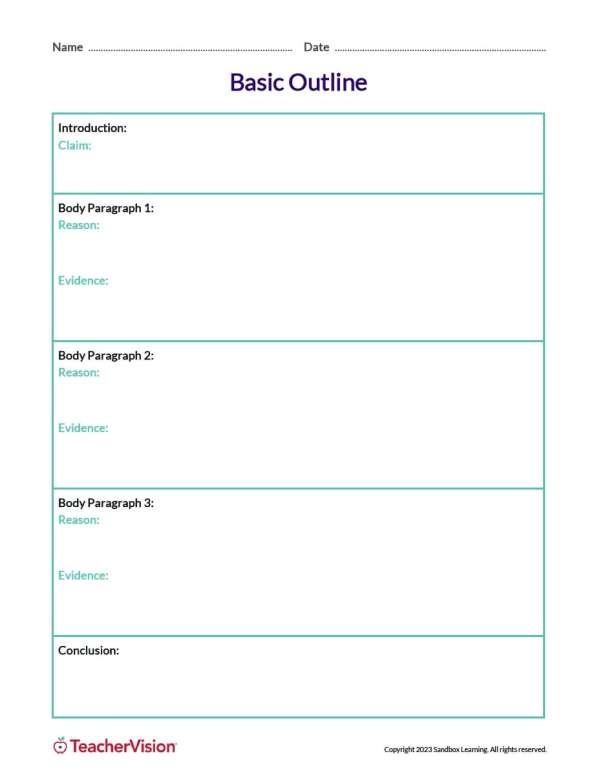
Guide your students' writing with this set of three multi-leveled argumentative writing graphic organizers.
Use this essay outline template for students who either do not need much support in writing a comprehensive argumentative essay and need only to jot down ideas or students who should just focus on Claim-Reason-Evidence for this round as a scaffolded step.
The claim should be an opinion or something that other people could reasonably disagree with. Reasons should each be different ideas that support their claim, and evidence should be facts -- either found through research or commonly known.
What's Included:
- Set of three graphic organizers: Basic, Intermediate, and Advanced

Fields Covered:
- Introduction- Argument Claim
- Body Paragraph 1- Argument: Reason and Evidence and Examples
- Body Paragraph 2- Argument: Reason and Evidence and Examples
- Body Paragraph 3- Counter Argument: Reason and Evidence
Featured Middle School Resources

Related Resources
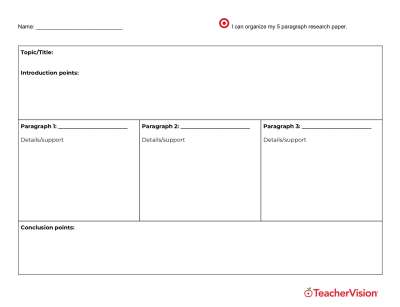
Argumentative Essay Guide
The Ultimate Guide to Argumentative Essay Writing
18 min read
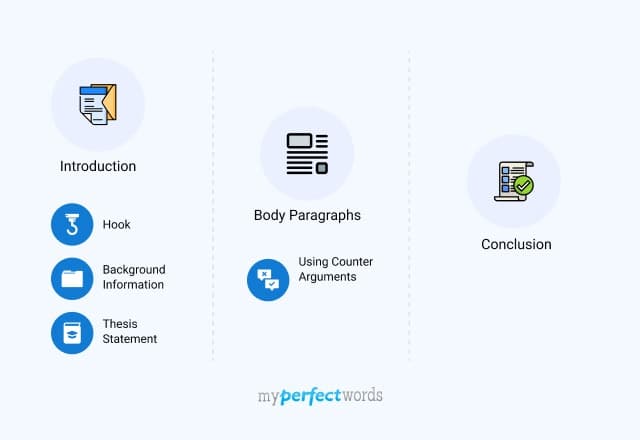
People also read
250+ Argumentative Essay Topic Ideas To Help You Out
Argumentative Essay Outline: How to Structure Your Argumentative Essay
Argumentative Essay Examples: Samples & Tips
Learn the 3 Different Types of Argument and Multiple Argument Claims
Are you struggling to write an argumentative essay? Do you want to learn the essential tips and techniques to craft a convincing argument?
Argumentative essay writing needs more than just a personal opinion. It requires you to present evidence and facts to support a claim. But where do you begin?
Look no further! This blog post will provide an in-depth guide on how to write an effective argumentative essay.
Read on to learn how to craft a perfect argumentative essay in this simple step-by-step guide.

Tough Essay Due? Hire Tough Writers!
- 1. Argumentative Essay Definition
- 2. Five Types of Argument Claims
- 3. Three Argument Structures and How To Use Them
- 4. How to Outline an Argumentative Essay?
- 5. How To Write An Argumentative Essay?
- 6. Argumentative Essay Format
- 7. Argumentative Essay Examples
- 8. Good Argumentative Essay Topics
- 9. Transition Words For Argumentative Essays
- 10. Argumentative Essay Writing Tips
Argumentative Essay Definition
An argumentative essay is a type of essay where the writer takes a strong stance on an issue and presents arguments for it.
These essays are built around a central argument. These arguments must be supported by logical evidence and facts. The primary purpose of an argumentative essay is to persuade readers to accept the writer's point of view on a particular topic.
It is similar to a persuasive essay. The only difference is, it is based on logic and evidence. Whereas, a persuasive essay may use emotional appeals.
Five Types of Argument Claims
There are five types of arguable claims that you can support in your essay. These include factual claims, definition claims, value claims, cause-and-effect claims, and policy claims.
Let's discuss each type in detail:
Factual Claims
These claims focus on facts and events that have occurred in the past. They can be supported with evidence such as statistics, examples, or expert opinions.
For instance, you could write an argumentative essay to support the claim that global warming is a man-made phenomenon. You would present evidence such as scientific research findings and expert opinions to back up your argument.
Definition Claims
These claims focus on the definition of something or a concept. You can use logic, historical facts, and evidence to support a definition claim.
For example, you could write an argumentative essay to define what “success” means for a person or organization. You would need to back up your definition by providing evidence from experts or historical data.
Value Claims
These claims focus on the value of something and can be supported with facts and expert opinions.
For instance, you could write an argumentative essay to argue that technology has a positive effect on our lives. You would present evidence such as surveys and studies that show how technology has made life easier and more efficient.
Cause and Effect Claims
These claims focus on how one event or action leads to another. They can be supported with evidence such as experimental data.
For example, you could write an argumentative essay to argue that poverty causes crime. You would need to present evidence from experts and other sources to back up your claim.
Policy Claims
These claims focus on specific initiatives or policies that people want to implement. They can be supported with evidence from experts and other sources.
For instance, you could write an argumentative essay with the data to support the implementation of a new government policy for healthcare reform. You would need to provide evidence such as reports and studies on the issue to back up your claim.
So, there are five types of arguable claims that you can make in your essay. Each type requires its own unique approach.
Three Argument Structures and How To Use Them
There are three main types of argument structures that may be used in an essay. Let's see how each of them works:
Classical (Aristotelian) Argument
The classical argument structure is the oldest and most common type of argument. This model has its roots in the works of the ancient Greek philosopher Aristotle.
It consists of five parts:
- Introduction
- Your Arguments
- Counter Arguments
To construct a classical argument essay, you would need to:
- Present your position on an issue
- Provide evidence to support it
- Acknowledge opposing views
- Refute those views with evidence
- Conclude by summarizing the main points.
Rogerian Argument
The Rogerian model is used in essays where the main purpose is to find a common ground between opposing sides. It was developed by psychologist Carl Rogers.
It consists of four parts:
- Both Sides Of An Issue
- Common Ground
To construct a Rogerian argument essay, you would need:
- To present your side of the issue
- Acknowledge and present the opposing view
- Find a point of agreement between them
Toulmin Argument
The Toulmin structure is less common than the other two but it has its own unique style. This model was developed by British philosopher Stephen Toulmin. It consists of six parts:
- Rebuttal of opposing arguments
- Conclusion.
To construct a Toulmin model argument, you have to:
- Present your claim on an issue
- Provide evidence to back it up (grounds)
- Support that evidence with additional information (backing)
- Acknowledge any possible exceptions (qualifier)
- Refute the counter-arguments (rebuttal)
It is important to choose the right structure that best fits the needs of your essay.
Watch this video that explains the three different types in detail:
How to Outline an Argumentative Essay?
When writing an argumentative essay, it is important to create an outline. An outline will help you organize your arguments and keep track of the flow of your essay.
Here is a basic structure for outlining an argumentative essay:
Following this structure will help you organize your essay and ensure that it is easy to read and understand.
Read more about creating an argumentative essay outline and master the art of essay structure.
How To Write An Argumentative Essay?
Here are the basic components of an argumentative essay that you need to write:
Argumentative Essay Introduction
- Argumentative Essay Thesis Statement
- Argumentative Essay Body Paragraphs
- Using Counter Arguments
Argumentative Essay Conclusion
Let's explore how to write each argumentative essay component in detail:
An argumentative essay introduction clearly states the writer’s claim that he will make in the essay. The introductory paragraph should be logical and intellectual and should be written persuasively.
Here are three steps you can follow to write a very persuasive argumentative essay introduction:
- Start with a hook: Begin your introduction paragraph with a strong hook that gives the reader a hint about your argument.
- Give background information: Provide brief background information necessary to understand the argument and smoothly transition into the thesis statement .
- State the thesis: Lay a solid foundation for your claim by stating your thesis statement.
Argumentative Essay Thesis Statement
The thesis statement is a concise, clear, and one-sentence summary of the whole essay. It is the most important part of an argumentative essay because it establishes a foundation for your claim. It should be informative, engaging, arguable, and valid.
One of the ways of writing an argumentative thesis is to make a question out of your topic. Simply take your essay topic and turn it into a debatable question.
Here is the thesis statement example for an argumentative essay:
Argumentative Essay Body Paragraphs
The body paragraphs involve topic sentences and evidence, either against or supporting a certain point of view.
Here are three simple steps for crafting the body paragraphs:
- Topic sentence: Start each body paragraph with a topic sentence that defines only one specific idea and supports the main claim.
- Provide evidence: Provide as much supporting evidence as required to convince the reader. Remember! The argument has no value if it is not backed with proper and relevant evidence from credible sources.
- Concluding remarks: End the paragraph with a concluding remark and smoothly transition to the next body paragraph.
Using Counter Arguments
This counter-argument paragraph contains the opposing point of view that a reader may pose against your main argument. This paragraph aims to prove that the opposing side is wrong by providing facts and evidence.
Below are the four steps to craft a counter-argument paragraph:
- State the counter-arguments: Present all the counter-arguments one by one.
- State your response: Provide your response towards the counter-arguments.
- Refute the opposing claims: Refute the opposite claims, one by one, with facts and evidence..
- Conclusion: Conclude the paragraph by reasserting your main claim of the essay.
The conclusion needs to be logical and precise that inspire the reader to agree with your claim. It should provide the final stance about the argument, which tells that your side of the argument is right.
Here are the three steps to writing an effective argumentative essay conclusion:
- Summarize the argument: Sum up the entire essay and rewrite the thesis statement
- Stick to the plan: Don’t introduce any new argument here; just synthesize all the information presented in the body paragraph.
- Call to action: End your essay by providing a call to action.
Argumentative Essay Graphic Organizer

Argumentative Essay Format
Writing a compelling argumentative essay involves more than just great content; proper formatting is equally crucial.
Here is the argumentative essay paragraph format example. Follow these guidelines to ensure your essay is well-structured and visually appealing:
- Paper Size and Margins
- Use standard letter-size paper (8.5 x 11 inches) or A4 paper.
- Set margins to 1 inch (2.54 cm) on all sides of the page.
- Font and Spacing
- Choose a legible font such as Times New Roman, Arial, or Calibri.
- Use a 12-point font size for the main text.
- Maintain double spacing throughout the entire essay, including the title, headings, and references.
- Include a title page with your essay title, name, instructor's name, course name/code, and submission date (in the upper left or center).
- Use proper formatting for the title, such as bold or italics.
- Header and Page Numbers
- Insert a header at the top right corner of each page, including your last name and page number.
- Page numbers should be in Arabic numerals (1, 2, 3...) and start on the title page if required by your instructor.
- Create a centered and bolded title for your essay.
- Capitalize the first letter of each major word in the title.
- Avoid underlining or using quotation marks for the title.
- Begin your essay with a clear and engaging introduction.
- Introduce the topic, provide background information, and state your thesis statement.
- Headings and Subheadings
- Use a consistent system for headings (e.g., bold, italics, or underlining).
- Organize your essay with clear headings and subheadings to guide readers through your argument.
- Body Paragraphs
- Start each body paragraph with a topic sentence that relates to your thesis.
- Provide evidence, examples, and analysis to support your argument.
- Use transition words to ensure a smooth flow between paragraphs.
- Counterarguments
- Address counterarguments within your essay.
- Refute opposing viewpoints logically and with evidence.
- Summarize your main points.
- Reiterate your thesis statement.
- End with a thought-provoking closing statement or call to action.
- Citations and References
- Use proper citation style (e.g., APA, MLA, Chicago) as required by your instructor.
- Include a separate page for references or works cited, listing all sources used in your essay.
By adhering to these formatting guidelines, your argumentative essay will not only convey your ideas effectively but also make a professional and organized impression on your readers.
Argumentative Essay Examples
Sample essays play a vital role in understanding the structure of an essay. So check out these examples below.
Argumentative Essay Template
Argumentative Essay Sample
Argumentative Essay About Gun Control
Argumentative Essay Examples College
Argumentative Essay Example For High School PDF
Argumentative Essay on Pollution Due to Urbanization
Argumentative Essay on Social Media
How To Start An Argumentative Essay Examples
Abortion Argumentative Essay Examples
Here are more argumentative essay examples to help you understand the structure of an argumentative essay.
Good Argumentative Essay Topics
Choosing a topic for an argumentative essay is way more complicated than choosing a topic for any other essay. To get enough material to write about, your topic should be:
To get enough material to write about, here are some easy argumentative essay topics for students:
- Coronavirus is more of a blessing for the earth than a curse.
- Human beings are more dangerous for mother earth than any other creature
- Most of the young people can work from home
- Social media have caused social problems
- Single parents can't do the same upbringing of kids as both parents do.
- The death penalty should be abolished
- Animals shouldn't be kept in captivity
- Climate change is caused by human activity
- Schools should provide mental health education
- Universal basic income should be implemented
If you want to get more unique argumentative essay topic ideas, have a look at our blog with 200+ argumentative essay topics !
Transition Words For Argumentative Essays
Transition words are crucial in argumentative essays to guide readers through your arguments and enhance the coherence and flow of your writing. Here are some essential transition words and phrases to strengthen your argumentative essays:
- Additionally
- On the contrary
- For instance
- Consequently
- Nonetheless
- In conclusion
Argumentative Essay Writing Tips
Writing an argumentative essay can be a challenging task, especially if you are unsure of how to get started. Here are some tips to help you write a good and persuasive argumentative essay:
- Choose a Debatable Topic: Pick a topic that has two opposing sides and can be debated. It should also be relevant to the course or subject you are writing about.
- Do Your Research: Before you start writing, it is important to do some extensive research on the topic so that you understand both sides of the argument. This will help you make an informed decision when writing your essay.
- Write a Clear Thesis Statement: Your thesis should state the main point of your essay clearly and concisely so that readers know what to expect.
- Develop Your Arguments: Once you have chosen your topic and done your research, you can start developing the arguments that you will use in your essay. Make sure that each argument is supported with evidence from reliable sources.
- Keep it Organized: An outline will help keep your essay organized and focused on the main points that you want to make.
- Be Unbiased: When writing an argumentative essay, it is important to remain impartial and present both sides of the argument in a fair and balanced way.
- Use Proper Formatting: Different styles have different formatting requirements, such as font size and type, margins, and line spacing. Make sure to follow the guidelines for your chosen style.
- Proofread: After you have finished writing your essay, it is important to take time to proofread and make any corrections or revisions that are necessary.
By following these tips, you can write an effective argumentative essay that will help you get the results that you want.
To finish it off,
Argumentative essay writing requires strong research and analysis skills to develop a sound argument. With the right planning and structure, anyone can write an effective argumentative essay.
Now that you have learned about the basics of writing an argumentative essay, it is time to start putting your ideas into practice. Choose a topic that you are passionate about and start writing!
However, we understand that students face many difficulties while writing an essay. If you are one of them, don’t worry, we’ve got a solution for you!
Our argumentative essay writing service is here to help you out. We've got qualified and professional writers who provide excellent writing assistance at affordable prices. We write all the papers from scratch to meet your custom requirements and ensure zero plagiarism.
So place your order at the best essay writing service today!
Frequently Asked Questions
How do you identify an argumentative essay.
In order to identify an argumentative essay, there are three steps:
- First figure out the purpose of a message. Who is trying to convince you? What do they want from you?
- Second, determine what their conclusion might be—what will it take for them to feel that their goal has been accomplished?
- Finally, think about reasons why someone would believe something and consider if any apply here.
Does an argumentative essay have a title?
An argumentative essay should have a title. This should give the reader an idea of what you're writing about.

Write Essay Within 60 Seconds!

Nova Allison is a Digital Content Strategist with over eight years of experience. Nova has also worked as a technical and scientific writer. She is majorly involved in developing and reviewing online content plans that engage and resonate with audiences. Nova has a passion for writing that engages and informs her readers.

Paper Due? Why Suffer? That’s our Job!
Keep reading
-9387.jpg&w=828&q=75)
Free Editable Essay Graphic Organizer Examples
Essays are complex and large write-ups that are not easy to intercept. That’s why it is better to use an essay graphic organizer to visualize your complex structured outline in a simple manner. In fact, there is nothing better than some free graphic organizer examples that save both your time and effort. So, let’s have an overview of this essay organizers and free example templates.
1. What is Essay Graphic Organizer
An essay graphic organizer enhances your research with visual elements. It helps the writer to correlate facts, observations, and notions. On top of that, it outlines the essay and provides an organized strategy for the writer.
A graphic organizer for writing helps the writers to tackle hard and long essay formats. A writer can use its visual aid to complete the write-up step by step. A graphic organizer for essays has different types based on primary functions.
- An Outline Based Essay Organizer
These types of essay organizers have at least 3 thesis. The whole story revolves around these. Moreover, the organizer includes specific supporting details and subtopic names that make the way crystal clear for writers. However, these organizers do not need much essay explanation. Most indications are worldly phrases that direct the attention toward thoughts and observations.
- A Contrasting Essay Organizer :
As the name indicates, it helps the writer to organize varying thoughts about topics and compare them. Moreover, it helps the writer to collect, conceive and portray the information ahead of time. The writer can use it for two collective primary topics or a single point from both topics. In both cases, the essay organizer will help them take visual notes and use them to their advantage while writing.
- Organizer For A Persuasive Essay :
The persuasive essay organizer helps the writer to persuade an audience toward a single topic. It includes three or more supporting details for the topic. Furthermore, the organizer includes written evidence for those details that help prove the point.
2. The Essay Graphic Organizer Examples
Using an essay graphic organizer for writing brings credibility and flexibility to your essays with extensive research. Essay writing is a tough job, especially if it has more than one subtopic.
Essays require tons of details. All that quality is up to no good if it is not organized and well structured. An essay organizer for writing helps you understand how the minor details contribute to overall concepts. With thorough research and long formats, essay writing may become dull. However, an organizer helps you to perfectly structure your thoughts with appealing visuals that make them engaging and far less challenging.
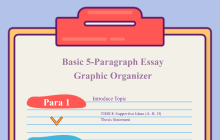
Basic 5-Paragraph Essay Graphic Organzier
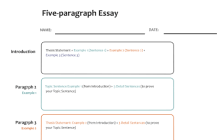
5-Paragraph Essay

Expository Essay Graphic Organizer
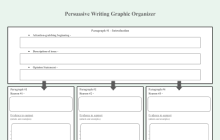
Persuasive Essay Graphic Organizer

Essay Graphic Organzier
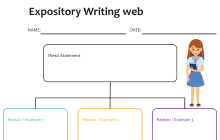
Narrative Essay Graphic Organizer
Example 1: 5 Paragraph Essay Graphic Organzier
The most common type of essay writing format is a 5-paragraph essay. Essay graphic organizer for writing helps organize all those 5 paragraphs and insert valuable information inside them. It includes the first paragraph section in which the writer inserts the topic sentence and at least three thesis statements. The upcoming three paragraphs briefly summarize those statements and provide at least three pieces of evidence for each thesis. Finally, the last paragraph repeats the main statement and includes an overall concluding statement. Moreover, every thesis detail includes a conclusion statement that conceives the entire concept.

Example 2: Printable 5 Paragraph Essay Graphic Organizer
It is also the type of essay organizer writers use to organize the outline of a 5-paragraph essay format. Its first paragraph is of introduction which includes with a thesis statement instead of a topic sentence. The statement inside the paragraph includes three supporting examples with itself. Moreover, the second paragraph has a topic sentence that the previous thesis supports. Plus, it has individual evidence details that prove the topic sentence true. The third paragraph includes a thesis statement that correlates with the previous and upcoming topic sentence. Finally, the last paragraph has the essay's main idea and a concluding statement that proves the point.

Example 3: Argumentative Essay Graphic Organizer
This template solemnly deals with the expository template of the essay. It focuses on the essay's three most basic parts: the introduction, body, and conclusion. Moreover, the writer evaluates the selected topic in it with examples and evidence and closes the argument clearly and concisely. The exemplary diagram includes 2 separate boxes in the introduction sections. One of them is for the hook that engages the audience, whereas the other depicts the essay's main idea. Inside the body section, the writer briefly lists three examples, each with individual supporting details. Finally, the conclusion includes two sections; one for reviewing and rewriting the central concept and the other to input the closing details of the essay.

Example 4: Persuasive Essay Graphic Organizer
This example diagram of the essay graphic organizer for writing helps to persuade a general or specific audience toward your point of view. The primary purpose is to enlist your opinion and evaluate it with the help of numerous supporting details. As for the organizer, it is for a 5 paragraph format. The first one has an engaging beginning, a summary of the issue, and your opinion. Furthermore, the next 3 provide different reasons that support your opinion. Moreover, the section also includes evidence in the form of examples and textual details that support every reason individually. The last paragraph is a conclusive one that restates the opinion, summarizes all three reasons again, and gives a CTA (call to action) at the end. However, you can ditch the CTA and add a simple closing statement that supports your opinion.

Example 5: Informational Essay Graphic Organizer
This type of organizer is for essays having more than one main idea. The organizer's interface has several colors that make it engaging and appealing. Due to the color, it is referred to as a Rainbow essay organizer. A big individual box includes the whole organized outline of the essay. The writer has to briefly write all three ideas in it and support their point of view. Moreover, the organizer includes an introduction and conclusion description. At last, there is a final draft section that concludes the whole essay and supports either all three or one suitable main idea.

Example 6: Narrative Essay Graphic Organizer
The expository essay is a genre that requires the student to investigate an idea, evaluate evidence, expound on the idea, and set forth an argument concerning that idea clearly and concisely. The below expository essay web diagram is created using EdrawMax Online and shows blank spaces for Thesis Statement, Example 1, Example 2, Example 3, Details about all the examples, and argumentative points. Expository writing gives facts and information about a topic, and as the web diagram suggests, a good expository essay introduces the main idea and develops it with facts and supporting details.
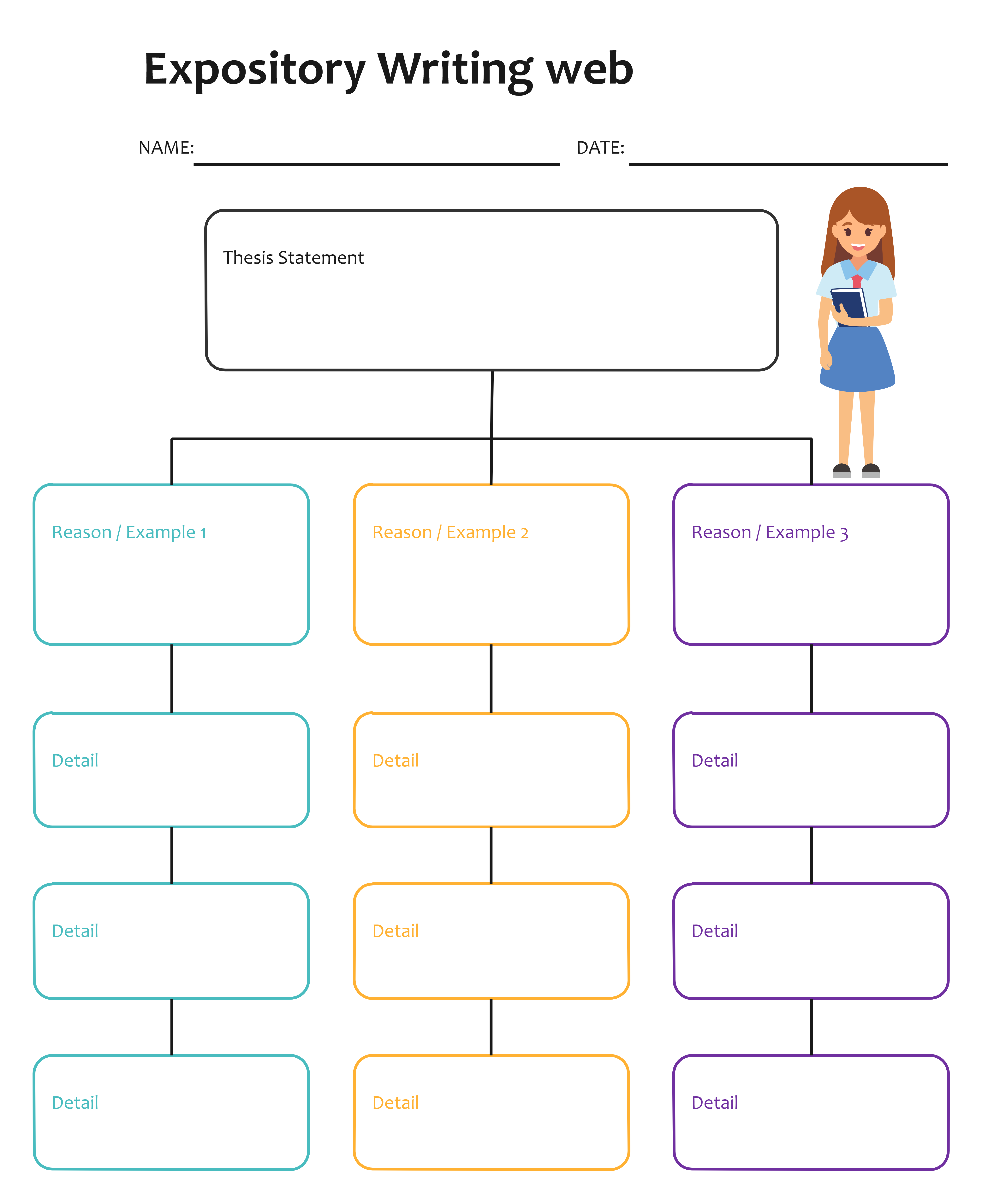
3. How to Make an Essay Graphic Organizer
Graphic organizers are the modern way of learning. With passing time, people are using them in every type of write-up. Therefore, it is better to understand its production process so that you can make one specifically for your essay. The online production software uses four simple steps to generate a graphic organizer for essays.
Step 1 - Head on to EdrawMax Online or download EdrawMax . Make an account and log in to it.
Step 2 - Once inside, you can start creating the graphic organizer on a blank edit sheet or readymade essay organizers, such as mindmaps and spider maps. However, this process is time-consuming. If you want an easy solution, head to the main menu on the left, look for Templates Community , and click on it.
Step 3 - Clicking on the Template Community option will take you to a social network of designers and a general audience like you that post templates daily for public use. You can search for your very own template and duplicate it onto your sheet using the button Duplicate.
Step 4 - Finally, start customizing it as you like. You can change the font, color, and components. Moreover, you can add new ones if you like. Once you are done and satisfied, export and share your template with others using the Button Publish present on the top right corner.
4. Online Graphic Organizer Maker
Traditional ways are gone when you had to work extensively for a simple diagram in lining software. Online graphic organizers like EdrawMax made graphic organizer designing much easier and less time-consuming. All thanks to its easy-to-use interface and basic yet helpful tool kits, designing a diagram is possible for every individual with basic knowledge.
Moreover, EdrawMax saves a lot of effort and time with the help of readymade templates. This online graphic organizer maker is suitable for any type of consumer to generate any variation of the graphic organizer. Its biggest pro is the Templates Community , with thousands of readymade templates for users. In this social biome, you can not only pick the one that suits you well but share your ideas with the community as well.
5. Key Takeaways
The visual aid of essay graphic organizers helps the writers to organize their researched facts and general thoughts according to references. Moreover, it gives a direction to the audience and the writer for the essay. As for its usage, the writers are helping themselves with it in their professional careers. Moreover, it proves exponentially efficient in the academic field for students. When it comes to essay writing, it helps in both of these by establishing a relevant and valid connection. Plus, communicating our thoughts with visual sketches and doodles is less boring and more engaging.
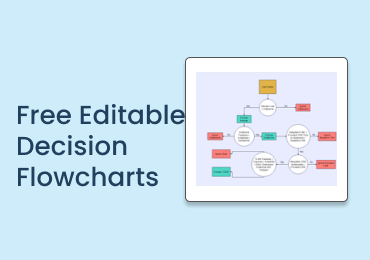
Free Editable Decision Flowcharts
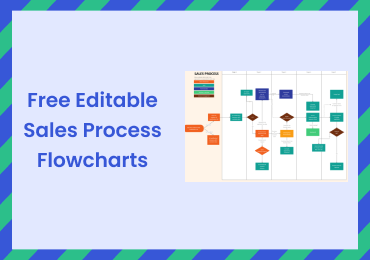
Free Editable Sales Process Flowcharts

Free Editable Flowchart Infographic Examples

Free Editable Sports Infographic Examples

Free Editable Roadmap Infographic Examples
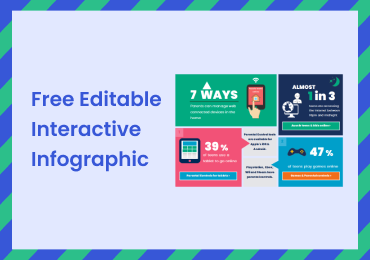
Free Editable Interactive Infographic Examples

Argumentative Essay Graphic Organizer and Sample - Digital & Printable Argument

- Google Drive™ folder
What educators are saying
Also included in.
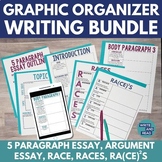
Description
Do your students struggle writing argumentative essays? This argument essay graphic organizer resource walks students through the writing process step by step. The unit provides an argument essay outline, topic planning guide, graphic organizer for each paragraph, format sample, and final copy directions. This is a great resource to support struggling students and students with IEPs. There is no prep for you. Just print and go or assign online.
This argument essay graphic organizer resource includes
- digital version for Google Slides
- printable PDF version
- argument essay outline
- argument planning guide
- graphic organizer page for each paragraph
- format sample
- final copy directions
Check out all of my writing resources:
Narrative Writing Unit (Digital and Printable)
Five Paragraph Essay Graphic Organizer
Argumentative Essay Graphic Organizer and Sample
RACE, RACES, and RA(CE)2S Graphic Organizers
Let's Connect!
Write and Read Blog
Write and Read on Instagram
Write and Read on Pinterest
Write and Read on Facebook
Write and Read on TikTok
Click here to follow my store for news about product updates and sales!
Questions & Answers
Write and read.
- We're hiring
- Help & FAQ
- Privacy policy
- Student privacy
- Terms of service
- Tell us what you think

COMMENTS
The Persuasion Map is an interactive graphic organizer that enables students to map out their arguments for a persuasive essay or debate. Students begin by determining their goal or thesis. They then identify three reasons to support their argument, and three facts or examples to validate each reason. The map graphic in the upper right-hand ...
Persuasive Essay Graphic Organizer Argumentative Essay Graphic Organizer INTRODUCTION Paragraph ØAttention-Getting Hook - ØDescription of Issue - (introduce the topic) ØYour CLAIM - (your opinion on the topic) EVIDENCE Paragraph Claim #1 - Example to support (use ethos, pathos, logos) -
Argumentative Essay Graphic Organizer Paragraph 1: INTRODUCTION Attention‐grabbing opening: Background of Issue: My position: (May include counter‐argument) Paragraph 2: Reason #1 Supporting Evidence: √ √ √ Paragraph 3: Reason #2 Supporting Evidence: √ √ √
1. First evidential support of your reason (known as confirmatio) 2. Second evidential support of your reason, then third, and so on. B. Summarize your first reason again and tie it together with evidential support. III. Second reason, etc. A. Continue to list your reasons in the same format as the first.
The elements of an argumentative essay introduction are: Hook: This is a sentence that captures grabs your readers' attention. A hook makes them curious about the topic of your essay. 4 hooks work great with argumentative essays: Ask an interesting question. State a fact/statistic. Make a strong statement.
Save time by showing you where each piece of the essay "lives." Have more productive brainstorming sessions, either by yourself or with a group. Make connections between ideas and create a more cohesive argument. Pinpoint holes in your arguments and either adjust the thesis or find supporting statements. Keep track of your research.
Make a claim. Provide the grounds (evidence) for the claim. Explain the warrant (how the grounds support the claim) Discuss possible rebuttals to the claim, identifying the limits of the argument and showing that you have considered alternative perspectives. The Toulmin model is a common approach in academic essays.
Use this graphic organizer to develop a persuasive stance for an essay, speech, poster, or any type of assignment that incorporates persuasion. Teaching with this printout ; More ideas to try ; ... The Persuasion Map is an interactive graphic organizer that enables students to map out their arguments for a persuasive essay or debate. Grades . 6 ...
Exploring Argument Writing With Visual Tools. Teachers can have students use graphic organizers and timelines to clarify their thinking during the writing process. By Jason DeHart. January 4, 2024. Keith Alexander Lee / The iSpot. As a teacher who loves to write and engage students with writing, I've experienced many challenges in attempting ...
When you're writing a persuasive essay, you need more than just an opinion to make your voice heard. Even the strongest stance won't be compelling if it's not structured properly and reinforced with solid reasoning and evidence. Learn what elements every argumentative essay should include and how to structure it depending on your audience in this easy step-by-step guide.
Argumentative Writing: Graphic Organizer. 1. As in any essay, the first paragraph of your argumentative essay should contain a brief explanation of your topic, some background information, and a thesis statement. In this case, your thesis will be a statement of your position on the issue. You are making a claim! !
Writing an Essay: Graphic Organizer. Use this graphic organizer to plan your analytical/persuasive essay. The introduction should start with a broad statement and end with your thesis statement, which "zooms in" on the points you will explore in more depth. The body paragraphs must contain evidence to support your thesis.
5) Re-read your paper! Many issues that might hamper flow are small/general enough that you can catch them just by proofreading-i.e., sentence fragments, clunky/lengthy sentences, etc. Reading your paper out loud is especially helpful for catching awkward phrases/sentences. Addressing "Flow": Tips for Organizing an Argumentative Essay.
First proposed by author Stephen Toulmin in The Uses of Argument (1958), the Toulmin Method emphasizes building a thorough support structure for each of an argument's key claims. The basic format for the Toulmin Method is as follows: Claim: In this section, you explain your overall thesis on the subject. In other words, you make your main argument.
Argumentative Writing Graphic Organizer. Guide your students' writing with this set of three multi-leveled argumentative writing graphic organizers. Use this essay outline template for students who either do not need much support in writing a comprehensive argumentative essay and need only to jot down ideas or students who should just focus on ...
When it comes to an overall structure for argumentative essays, you need to consider several things: • The claim you plan to make. • The arguments and evidence you have for that position. • The position your opposition holds. • The arguments and evidence your opposition has for that position. In the next few pages of this handout, you ...
Graphic Organizer for a Toulmin argument How to use this organizer: This organizer is meant to be used for an argumentative essay. Before completing the blanks on the far right, you should have an argumentative thesis and an audience in mind for your essay. Also, you will want to think about whether or not your essay is suited to a Toulmin ...
Argumentative Essay Graphic Organizer. Argumentative Essay Format . Writing a compelling argumentative essay involves more than just great content; proper formatting is equally crucial. Here is the argumentative essay paragraph format example. Follow these guidelines to ensure your essay is well-structured and visually appealing: Paper Size and ...
Example: Graphic Organizer for the Argumentative Essay Support your claim Refute the objections Would banning of assault weapons reduce crime? The production, sale, and possession of assault weapons for private citizens should be banned in the U.S. Evidence Barbaric public slaying: − Columbine School Shootings
Example 3: Argumentative Essay Graphic Organizer. This template solemnly deals with the expository template of the essay. It focuses on the essay's three most basic parts: the introduction, body, and conclusion. Moreover, the writer evaluates the selected topic in it with examples and evidence and closes the argument clearly and concisely.
You've found the perfect graphic organizer—complete with a fillable PDF option—to help students visually and clearly connect the integral elements of any persuasive, argumentative, and informative essay: from the claim, reasons, evidence, and conclusion, students can better organize and map out their thinking while understanding the general essay structure.
This argument essay graphic organizer resource walks students through the writing process step by step. The unit provides an argument essay outline, topic planning guide, graphic organizer for each paragraph, format sample, and final copy directions. This is a great resource to support struggling students and students with IEPs.